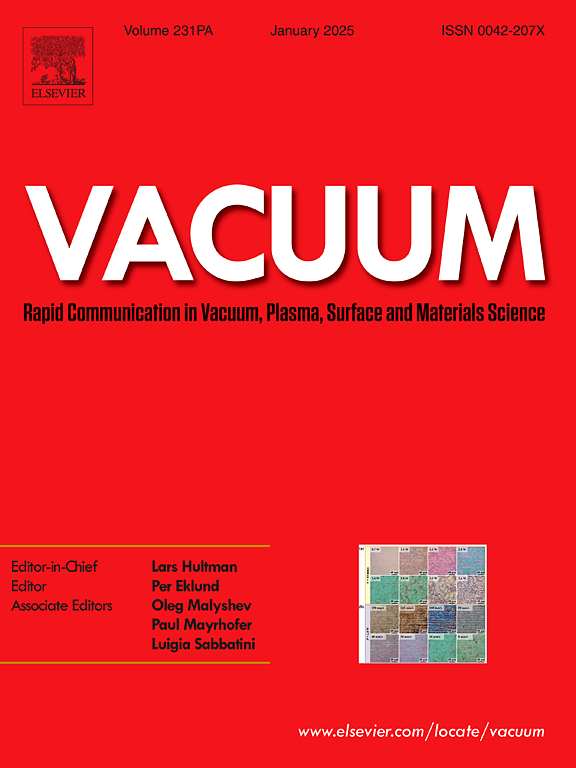Influence of Mo content on the metal-insulator transition of Mo-doped VO2 single crystals fabricated by fast thermal oxidation
IF 3.9
2区 材料科学
Q2 MATERIALS SCIENCE, MULTIDISCIPLINARY
引用次数: 0
Abstract
Vanadium dioxide (VO2) has demonstrated potentials for applications in sensors, actuators, intelligent windows, and devices for storing energy, owing to its unique metal-insulator transition (MIT) property at around 67 °C accompanied by a structural transition between rutile and monoclinic phases. In order to enhance its practicality at ambient temperature, Mo-doped VO2 single crystals with varying Mo contents were fabricated in the present work by a facile thermal-oxidation process in air. The Mo-doped VO2 single crystal exhibits a rod-shaped and hollow morphology with a rectangular cross-section. The influence of Mo doping on the phase transition behavior of Mo-doped VO2 single crystals was investigated. The analysis and energy dispersion spectrum maps revealed the homogenous distribution of Mo, V, and O elements across the single crystals, confirming successful doping. High-resolution transmission electron microscopy images and electron diffraction patterns verified the single-crystal characteristic of the Mo-doped VO2. X-ray photoelectron spectroscopy indicated the presence of mixed valence states of V (V4+ and V5+) and Mo6+, while differential scanning calorimetry measurements demonstrated a substantial reduction in the MIT temperature by approximately 50 °C/at% Mo, which reaches the highest decrease efficiency for metal-insulator transition temperature of element-doped VO2.
Mo含量对快速热氧化法制备Mo掺杂VO2单晶金属-绝缘体转变的影响
由于二氧化钒(VO2)在67℃左右具有独特的金属-绝缘体转变(MIT)特性,并伴有金红石相和单斜相之间的结构转变,因此在传感器、执行器、智能窗口和储能设备中具有应用潜力。为了提高其在常温下的实用性,本文采用空气热氧化法制备了不同Mo含量的掺杂VO2单晶。掺杂钼的VO2单晶呈棒状、空心、矩形截面。研究了Mo掺杂对Mo掺杂VO2单晶相变行为的影响。分析和能量色散谱图显示Mo、V和O元素在单晶上均匀分布,证实了掺杂的成功。高分辨率透射电镜图像和电子衍射图证实了掺杂mo的VO2的单晶特性。x射线光电子能谱显示了V (V4+和V5+)和Mo6+的混合价态的存在,而差示扫描量热测量表明,在% Mo时,MIT温度大幅降低了约50°C/,这是元素掺杂VO2的金属-绝缘体转变温度的最高降低效率。
本文章由计算机程序翻译,如有差异,请以英文原文为准。
求助全文
约1分钟内获得全文
求助全文
来源期刊

Vacuum
工程技术-材料科学:综合
CiteScore
6.80
自引率
17.50%
发文量
0
审稿时长
34 days
期刊介绍:
Vacuum is an international rapid publications journal with a focus on short communication. All papers are peer-reviewed, with the review process for short communication geared towards very fast turnaround times. The journal also published full research papers, thematic issues and selected papers from leading conferences.
A report in Vacuum should represent a major advance in an area that involves a controlled environment at pressures of one atmosphere or below.
The scope of the journal includes:
1. Vacuum; original developments in vacuum pumping and instrumentation, vacuum measurement, vacuum gas dynamics, gas-surface interactions, surface treatment for UHV applications and low outgassing, vacuum melting, sintering, and vacuum metrology. Technology and solutions for large-scale facilities (e.g., particle accelerators and fusion devices). New instrumentation ( e.g., detectors and electron microscopes).
2. Plasma science; advances in PVD, CVD, plasma-assisted CVD, ion sources, deposition processes and analysis.
3. Surface science; surface engineering, surface chemistry, surface analysis, crystal growth, ion-surface interactions and etching, nanometer-scale processing, surface modification.
4. Materials science; novel functional or structural materials. Metals, ceramics, and polymers. Experiments, simulations, and modelling for understanding structure-property relationships. Thin films and coatings. Nanostructures and ion implantation.
 求助内容:
求助内容: 应助结果提醒方式:
应助结果提醒方式:


